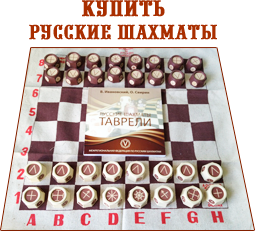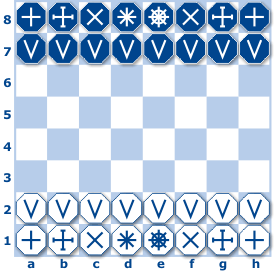Rules of the Game A game of Russian chess is played between two partners who take turns moving pieces (tavreli) on a square checkered board. The chessboard consists of 64 cells,
Rules of the game


A game of Russian chess is played between two partners who take turns moving pieces (tavreli) on a square checkered board.
The chessboard consists of 64 squares, 8 horizontals and 8 verticals. There are also black and white diagonals on the chessboard.
Each player has 16 pieces (tavreli).
Warriors are placed at the corners of the board. Near them are horsemen, then archers. In the center, on a field of his color, a prince is placed, next to the sorcerer. In front of the figures is a row of 8 warriors. Each warrior at the beginning of the game must be placed in front of the brand whose symbol is depicted on the bottom and side surface of the warrior's brand. In front of the sorcerer, a warrior with a helgi symbol is installed. The white tavrelis start the game.
A move is the movement of a tavrel (alone or as part of a tower according to the rules of the upper tavrel) from one field to another. None of the tavrels, with the exception of the helga (when the piece moves like a horseman), the sorcerer, the horseman and the warrior during castling, can not move through the field occupied by the opponent's tavrel. None of the tavrels is removed from the game board during the game.
All tavrels can, during their course, be placed on other tavrels (their own or a partner), forming towers.
Exception: not a single tavrel can be placed on a sorcerer.
The tower can be moved either completely or divided into two parts. At the same time, its lower part remains on the same field and the action of this part begins immediately (according to the rules of the upper tavrel).

Magus: can move to any adjacent field for 1 cell, if it is not under attack from enemy pieces. The sorcerer can form a tower if it is not under attack.

Fighter: moves to any field horizontally and vertically on which it stands. It cannot “jump” over tavreli, with the exception of castling. If his own or someone else's tavrel is located on the path of his movement, he is placed on top, forming a tower that will move according to the rules of the upper tavrel.

Archer: moves to any available space along the diagonal on which he stands.

Prince: moves to any field vertically, horizontally or diagonally on which it stands. The prince moves like an archer and a warrior. One of the strongest figures, second only to Helgi.

Rider: special piece on the chessboard. If the rest of the pieces move along straight or oblique lines, then the rider moves along a broken line: two squares straight and one square obliquely (of course, in one move). In addition, the rider is a tavrel that can jump over his own and other people's pieces. The rider can make his move in any direction, and this move always resembles the letter “G”.Depending on the direction in which the rider is moving, the letter G may look different.

Warrior: Moves forward to a square directly in front of him on the same file and not occupied by an opponent's tavrel. From the starting position, the warrior can advance 2 squares along the same vertical, if both these squares are free from enemy pieces. If these fields have their own taurels, then the warrior can form a tower with them, occupying the upper position.
A warrior who has already moved and during the game again got to the initial square on the 2nd and 7th horizontals, respectively, for white and black, loses the right to move forward 2 squares at once.
The warrior moves to the field occupied by the opponent's tower, which is located diagonally one cell forward, forming a new tower.
When the warrior reaches the furthest horizontal from his starting position, he turns over and turns into that tavrel in front of which he stood in the starting position and whose symbol is depicted on his lower and lateral surface. This transformation is part of the same turn.
If a turned warrior is placed on his own or an enemy's brand, he turns over and becomes an ordinary warrior.
The warrior, standing in the initial position in front of the sorcerer, under the conditions described above, turns into helgi.

Helgi: walks to any available field vertically, horizontally and diagonally on which it stands, as well as as a rider. Thus, the ability to move the helga corresponds to the combined capabilities of the prince and the rider.
This is the most powerful piece in Russian chess. Helgi can, without the help of other pieces, checkmate the opponent's sorcerer.
Castling:
You can castle once per game. Castling can be short or long. It is done as follows: the sorcerer moves towards the warrior through one cell, and the warrior is transferred through it and placed next to it. Castling becomes impossible if the sorcerer and the warrior who castling is done have already moved.
Castling is temporarily not possible if:
– the field on which the sorcerer stands, or the field that he must cross, or the field that he must occupy, is attacked by one of the opponent's tavrels;
– between the sorcerer and the warrior with whom castling is performed, there is some kind of tavrel on the same horizontal line.
Capture on the pass:
A warrior who has made a move through a field under attack by an enemy warrior can be captured. The opponent forms a tower, as if the move of the first warrior was only one field.
Shah:
If any tavrel – a prince, a warrior, an archer, a horseman, a warrior or a helgi attacks a sorcerer, then such an attack is called a check. It is necessary to defend against the check.
There are 3 ways to protect: you can move away as a sorcerer, capture the attacking tavrel, or put another tavrel between it and the sorcerer.
Mat:
If none of the ways to defend against a check can be performed (take the sorcerer away, capture the attacking tavrel, or shield the sorcerer with another tavrel), then the sorcerer checkmate is obtained.The party stops, and the player who received the mat, – loses. The party is considered won if you manage to declare the rival’s sorcerer’s mat, or if the opponent surrenders himself.
Draw:
The party may end in three cases:
- with mutual consent of rivals;
- If, in his turn, the player cannot make any move, with this sorcerer is not under the shah. This position is called Pat;
- At the request of one of the players, who has the same position three times (not necessarily in a row), the possibilities of moving the tavrets have not changed. A variety of such a draw is an eternal shah, when one of the parties continuously attacks the opponent’s woker, and the latter cannot hide from the shahs.
Party recording:
To write down a separate move or the entire batch, the following system is used: horizontal rows, starting from the playing with white tavrets, are indicated by numbers from 1 to 8, and the vertical rows from left to right from the playing with white – Latin letters A, B, C, D, E, F , g, h.
By calling the letter vertical first, and then the figure of the horizontal, you can indicate any field of the chessboard. Each Tavreli move is indicated by the designation through the hyphen two fields – where and where the taurus moved.







